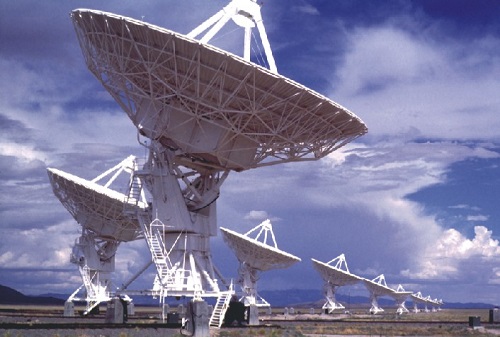What kind of assumptions do we bring to SETI, and how are those assumptions changing? Tau Zero’s Larry Klaes has some thoughts on that, along with suggestions about what a new book on the subject may want to include in its second edition.
By Larry Klaes
SETI, the Search for Extraterrestrial Intelligence, has traditionally operated on the premise that there may be beings in the Milky Way galaxy and beyond who are smart, aware, and interested enough to deliberately attempt to contact other similarly advanced societies in the Universe.
The primary purpose for such an effort would be to alert any potential celestial neighbors to their presence for the exchange of information and ideas about themselves, their home world, and their take on existence. Their methods of transmission would include certain forms of electromagnetic radiation which the various parties should have in common, such as radio and light waves. This Messaging to Extraterrestrial Intelligences, or METI, is considered to be not only less complex and faster than sending a robotic or crewed vessel from one star system to another – barring the discovery of a way to move faster than light (FTL) – but also far less expensive and much safer for both sides.
The alien version of METI is presumed to be conducted by scientists using not their native language but rather some form of basic mathematics for the initial efforts at getting our attention and conducting basic conversations. This remedial arithmetic would serve as the assumed common key to eventually allow both species to use their own conventional languages to exchange more detailed information.

This thinking is strongly reflected in the 1985 novel Contact (and the 1997 film version), the only major work of science fiction produced by astronomer, science popularizer, and SETI/METI pioneer Carl Sagan. In his story, Sagan envisioned a highly advanced, vast, and ancient alien technological civilization which transmits an initial message via radio waves to species they deem potentially worthy of dealing with. One day humanity receives this opening greeting from them in the form of the first one hundred prime numbers, which are digits divisible only by themselves and one. Prime numbers are a pattern produced by no known natural phenomenon.
On SETI Assumptions
If the bipedal residents of the planet Earth can detect and recognize the artificial nature of the primes being sent (“mathematics [is] the only truly universal language” declares the main character Ellie Arroway at one point in response to a visiting senator who wanted to know why the aliens didn’t just speak English) along with the subsequently more complex information which then follows, then one day we might be able join an entire galactic community of civilizations. This society would be similar to the United Nations, only on a celestial scale and with members of many different species from a diversity of alien worlds across space and time, yet somehow all managing to work together for the common cosmic good.
These assumptions, while not implausible, do reflect a particular scientific take regarding SETI, METI, and the nature and behavior of technological alien beings. The question is, does the fact that we have yet to confirm a recognizably artificial signal of extraterrestrial origin after six decades of modern SETI (and a handful of METI) activities mean that our scientific assumptions about intelligent aliens need to be revised, or have we just not been searching long and hard enough? Or perhaps both?
Since astronomer Frank Drake performed the first modern extraterrestrial hunt program in 1960 with a radio telescope search he called Ozma, SETI has traditionally been dominated by radio (and later optical) astronomers, as they are the ones who have conducted the majority of the searches for alien signals to the present era. Their parameters were and are still dictated by the contemporary limitations of what humanity can accomplish when it comes to interstellar distances and the paradigms of their fields and views on intelligent life elsewhere.
As for relevant disciplines outside of astronomy involved in SETI, there have been token representatives present going back to the first modern era SETI conferences, thanks in large part to Sagan. But usually the conferences and the projects were dominated by astronomers, who focused heavily on radio SETI and the technical details of such interstellar communications. Often they would use the famous Drake Equation (N = R* x fp x ne x fl x fi x fc x L) as their template but tend to gloss over the parts of that linear equation which were hard to quantify, which included most of it. This was especially done with fc and L, the fraction of civilizations that develop the means to let others in the galaxy know they exist and the overall lifetime of such technological societies, respectively.
Like most scientists, they felt comfortable with numbers, tangible facts, and mechanics. Why would an alien signal us? Well, because they could, so they would. They wanted to exchange knowledge because the operators had to be fellow scientists, which meant that even though they were alien, they had to think similarly to us, otherwise they would not be conducting METI/SETI. We were looking for versions of us, very specific versions if truth be told.

The accuracy of the statements is attested by Mark A. Sheriden’s excellent and insightful work titled SETI: A Critical History. From Chapter 10, Sheriden gives this quote from Dr. Jill C. Tarter, the recently retired director of the Center for SETI Research at the SETI Institute in Mountain View, California:
Not long after the [1979 NASA Life in the Universe] conference Jill Tarter, a key member of SETI’s second-generation leadership team, acknowledged that SETI was, indeed, “tuned” to find humanoids. “Those forms that we do find in this manner [i.e., a SETI-style search] will be more similar to life as we understand it than other forms that may exist. We put a filter on the problem.”
When asked what she would do differently if starting over again to study ETIs, Tarter responded with an echo of Shklovskii’s complaint prior to Byurakan-II, that the American SETI scientists failed to acknowledge the “complexity” of the problem they faced and, in particular, were ignoring the “humanities and biological aspects.” Tarter said, “I neglected biology, and civilizations, and paleontology.” In other words, she would have paid more attention to the “nature” aspects of the opportunity SETI represented.
Puzzling Out Alien Motivations
Why would an alien intelligence want to contact the stars? The possible motivations for such actions – or lack thereof – are just as important for the success of SETI and METI as figuring out how beings from another world (assuming the majority live on a planet or moon in the first place; another paradigm, perhaps?) might go about sending out signals into the galaxy.
Anthropologists, sociologists, biologists, and historians might have a clue in this area. At present they may have the native dwellers of only one planet to base their research and ideas upon, but at least it is a world with a very wide variety of life and an ancestry dating back at least 3.8 billion years.
These fields and their practitioners are given their due in the book Civilizations Beyond Earth: Extraterrestrial Life and Society, edited by Douglas A. Vakoch and Albert A. Harrison and published by Berghahn Books (New York, 2011). Vakoch, who also edited the book Communication with Extraterrestrial Intelligence (SUNY Press, New York, 2011) is the Director of Interstellar Message Composition at the SETI Institute and Professor of Clinical Psychology at the California Institute of Integral Studies. Harrison is Professor Emeritus in the Department of Psychology at the University of California, Davis.
Reading through the collected papers in Civilizations Beyond Earth reminded me of one of the first works I came across that was directly critical of the parameters modern SETI had laid down in its milestone years of 1959 and 1960, The Inner Limits of Outer Space by Dartmouth professor John C. Baird (Hanover, New Hampshire: University Press of New England, 1987). The author of the first major book on SETI by a professional psychologist, Baird was also part of Project Oasis, a NASA plan in 1979 to help design the multi-channel spectrum analyzer to be used in the space agency’s own burgeoning SETI project.
Baird pointed out how those involved in searching for extraterrestrial intelligences were spending a great deal of their time and resources in designing and building the instruments they planned to use, but not nearly as much in turn when it came to really thinking about what kind of beings might be out there and why they might want to conduct METI at all. Baird’s words and thoughts throughout The Inner Limits of Outer Space mirror what one finds twenty-four years later in Civilizations Beyond Earth. Neither work wants to do away with SETI so much as redefine it to improve the chances for success based on a more realistic or at least more open approach to alien life. The similarities also include the conclusion that even though current SETI is problematical in terms of detecting an actual extraterrestrial signal, it cannot hurt to keep trying for, to quote the current advertising motto of the New York State Lottery: “You never know.”
Among the highlights of Civilizations Beyond Earth which take it beyond the usual examinations of SETI and its related fields is the focus on what the general public, or laypersons, think and say about extraterrestrial life, in particular the intelligent kind.
Public Perceptions of ETI
Professional SETI researchers and other scientists tend to avoid the public perceptions about aliens, which they find to be full of undisciplined ideas and a tendency to buy into stories and reports about sightings of alien spaceships and their occupants. A fear of being lumped into the fringe realm of pseudoscience is among the top reasons why SETI has stuck with remote searches of distant star systems. However, there is a slowly opening acceptance that some ETI might send probes to our Sol system to observe us discreetly, perhaps in the Main Planetoid Belt or using nanotech devices or even smaller observing and data collecting technology scattered across Earth.
Several chapters of the book are devoted to polling the general public on the subject of alien life. Unrestrained by scientific parameters and paradigms, their theories and beliefs range from having aliens be the saviors of humanity to our destroyers. They also tend to be much more accepting of the idea that many ETI may already be here monitoring us.
In an ironic twist, the public often thinks of the physical appearance of alien beings as essentially humanoids with a large head and eyes, no visible ears, and slim bodies. On the other hand, scientists who focus on exobiology see life taking on many different forms on different worlds due to evolution. Nevertheless, because we know so little about life beyond Earth, a wide variety of viewpoints can be a welcome thing, as there are times when a different perspective on such a subject could be the key to discovery.
Among the most interesting papers in this collection were the ones where different human cultures interact with each other in space and time. In “Encountering Alternative Intelligences: Cognitive Archaeology and SETI”, Paul K. Wason looks at one of the fifteen humanoid species which have shared this planet with us, namely the Neanderthals. Although they existed in Europe around the same time with modern humans and even interbred with each other, their branch of the family tree died out roughly thirty thousand years ago. Clues from the archaeological record indicate that Neanderthals were quite different in many fundamental ways from current humanity despite being hominids which evolved on Earth. Even though their brains were a bit larger than ours, Neanderthal was not as sophisticated in many ways if we go by the evidence that has survived the ages. Regarding how scientists have learned as much as they do know about Neanderthals, Wason said: “Could it be also that one of the best ways of preparing for interstellar communication with other intelligences would be to engage in more study of how human intelligence works?”

Several centuries ago, there were two genetically related but otherwise very different human cultures which did interact with each other and for which we have extensive records of those encounters. In “The Inscrutable Names of God: The Jesuit Missions of New France as a Model for SETI-Related Spiritual Questions,” Jason T. Kuznicki, a research fellow at the Cato Institute, describes what happened when a group of Roman Catholic Jesuits sailed to North America starting in the Seventeenth Century to convert the native tribes living around the Canadian side of the Great Lakes region.
Armed with the tools of their religion, which included the presumptions of French philosopher Rene Descartes and Saint Thomas Aquinas that reason would inevitably bring everyone to the conclusion that the Christian God and souls exist, the Jesuit missionaries soon discovered that the Native Americans they met did not share these views or come to any of the same conclusions as the Jesuits thought would happen in matters of deities and the afterlife.
Here were fellow humans separated by a few thousand miles of ocean and yet the two cultures not only had wildly different views on many things, they also lacked the words of their languages to clearly get across their ideas on spiritual and religious matters. Now imagine what might take place between two entirely different species from separate worlds light years apart. Would an alien species even have a religion?
One aspect of Kuznicki’s paper which was not touched upon were the underlying motives for the Jesuits being in North America and attempting to convert the natives there: The French wanted to secure the New World for themselves from the competing British and Spanish powers. Having the Native Americans as allies would certainly help their cause, either through assimilation or coercion. Should an ETI contact us via interstellar transmissions or arrive in person at our world, this is one aspect of such an encounter that requires the study of historical precedents from our species. The scientists would assume the alien visitors are just explorers, but the historian might think otherwise. Even an ETI that came here with the purpose of doing what it thinks is good for us might have unexpected consequences for humanity.
The Question of Artificial Intelligence
Civilizations Beyond Earth does have its limitations. The focus is mainly on biological entities, which makes sense considering the authors. However, to not offer at least a few papers by some computer experts on artificial intellects, or Artilects as coined by Hugo de Garis, is hardly advancing our knowledge base of all scientific aspects of ETI. In this respect it is no better than focusing on radio as a means of interstellar detection and communication while ignoring Optical SETI and searching for Dyson Shells and alien probes in our Sol system.

Granted, there is a paper by William Sims Bainbridge titled “Direct Contact with Extraterrestrials via Computer Emulation”, which proposes the idea that a person could have themselves downloaded into a computer simulation as an avatar, or at least a psychological reproduction of themselves. Bainbridge envisions the avatars being beamed into space via radio waves to do the exploring and contacting with ETI.
Presumably this would have to be an enhanced version of the humans who choose to go this route, otherwise we encounter the limits of understanding an alien mind that would be little different than if we tried to comprehend an ETI with our own selves. Other chapters do deal with the complexities and difficulties in trying to communicate even basic concepts to an alien species, especially if we have few frames of reference. Would an Artilect with its faster computing speeds and much larger data storage do this better? Would sentience be required for this task or just a highly sophisticated simulation resembling awareness? Perhaps a revised edition of this book will add papers devoted to these questions concerning Artilects.
As Seth Shostak says in his article “Are We Alone?” regarding the Drake Equation, but which could also mirror what is missing and incomplete from this book:
“In other respects, [the Drake] equation might be too cautious. It assumes that all transmitting cultures are still located in the solar system of their birth. This ignores the possibility of colonization of other star systems (difficult, but not forbidden by physics), or the possible deployment of transmitting facilities far from home. In addition, it does not deal with the development of synthetic intelligence – thinking machines that would not be constrained to watery worlds orbiting long-lasting stars. In short, it makes the assumption that “they” are much like “us.”
For those who might argue that we may be unable to deduce the thought processes and motives of artificial minds far larger and faster than our own, the same could be said for any kind of biological alien species: Such beings could take on many forms and be just as inscrutable as an Artilect, yet that has not stopped many humans of all stripes on this planet from offering their views on organic ETI. One advantage with Artilects is that we can work towards actually creating or simulating them and thus have direct access to another intelligent mind.
Unfortunately, many people fear that Artilects could use their superior intellects to dominate or destroy humanity, just as they also expect advanced ETI to arrive in starships with similar goals. Whether that may ultimately happen or not, this general fear combined with a limited education on and cultural ridicule about the subjects relevant to SETI/METI have made their “contributions” to the reality that over half a century after the first serious SETI program, traditional searches continue in a largely sporadic fashion with limited funds, seldom expand beyond the radio and optical realms, and remain dominated by astronomers and engineers.
Human Expansion into the Galaxy
These views and paradigms also extrapolate to interstellar efforts such as Worldships, self-contained vessels carrying thousands of people on multigenerational journeys to other star systems. The goal of these Worldships is to colonize suitable planets and moons in the target system or at least collect resources from them before moving on to other galactic destinations.
How those who will remain onboard for perhaps many centuries will survive and adapt has been studied far more in the pages of science fiction than anywhere else, for obvious reasons. Will those who arrive at their intended worlds be radically different from their ancestors back on Earth? Will their interaction with any ETI they encounter diverge from the initial intentions of those who sent them off into the galaxy? As said earlier regarding Artilects, perhaps a revised edition of this work or a new book altogether devoted to very long term exploration and its consequences on those who make the voyage both aboard the Worldship and upon the places they settle will make inroads to answering these questions.
There is a strong desire or perhaps even a natural reaction to colonize any Earthlike exoworlds as part of some cosmic manifest destiny. Unless we terraform some barren rock, a planet similar to our own will be so not only in terms of size and environment, but also due to having life upon it. Even if none of the organisms on this alien world are sentient (and how exactly will we define that?), do we have the right to introduce terrestrial species there? If the situation was reversed and an ETI arrived at Earth to set up a new home, even if they desired a peaceful coexistence, imagine the reaction from humanity.
Even a robotic mission could cause unforeseen issues in the future. Already at this early stage in our expansion into space we have five probes and most of their final rocket stages heading beyond the boundaries of the Sol system into the wider Milky Way galaxy. Although none of them will be functioning by the time they could ever reach another star system, their very existence drifting and tumbling uncontrolled and aimless through deep space might one day become a problem for beings of which we are completely unaware at present.
We can declare that the galaxy is much too vast and these probes far too small to ever gain notice by any intelligences out there. We can say that any beings who could find these emissaries from Earth would have to be quite sophisticated and savvy with the ways of the interstellar realm and thus capable of dealing with a comparatively primitive, ancient, and inactive derelict from a species such as us.
In the end, however, the truth is that we do not yet know who or what is occupying the galaxy with humanity. We cannot say with certainty how an alien species might react and respond to an unexpected visitor from another world – though we can make some pretty good guesses as to how our civilization would behave in a similar scenario.

As we have already discussed with regards to SETI and METI, again the astronomical scientists and space engineering and technical fields often differ in their views on these matters compared to the anthropologists, sociologists, biologists, and historians. At least some of the gaps between the disciplines were bridged by the incorporation of messages and information packages on the Pioneer, Voyager, and New Horizons space probes. Whether these “gifts” will be recognized and understood by the recipients is yet another unknown factor, but they are a step in the right direction.
The issue of our physical intrusion into the Milky Way will become even more prominent and serious as we develop and launch probes – operated by Artilects most likely – designed to reach and explore other solar systems. In this case, humanity may receive responses from other intelligent beings in a matter of years or decades as opposed to millennia. What may happen and how our descendants might handle an ETI reaction will depend on how far our culture has come in terms of being more wide ranging and inclusive in our understanding of the Cosmos.
Civilizations Beyond Earth may be a slim book, but it is a good introduction to fields that need to be vital parts of any serious discussion of the scientific activities regarding extraterrestrial intelligences. If SETI and METI remain lopsided in their thinking, methods, and executions, the stars will likely continue to remain silent for the human species for a long time to come.
Not to know if we are either alone or one of many living beings in the Universe when we finally have the awareness and ability to answer this very important question would be a tragic shame, an affront to the very reason we have science and a civilized society in the first place. Let us not answer the L portion of the Drake Equation too soon from a lack of wonder, education, and funds.




What Ender’s Game Gets Right About Communicating With Aliens
BY ADAM MANN 11.01.136:30 AM
Ender’s Game is about a misunderstanding.
I know, I know. The story is about a terrible war and child soldiers and morality and all that. But at the core of the movie, which opens this weekend, and the book it’s based on is the failure to understand an alien species. Not to be too spoilery, but it is this basic confusion that fuels the conflict between humans and the alien civilization known as the Formics. And this inability to comprehend another intelligent species might be closer to the truth than is generally thought.
In most popular works of science fiction, communicating with extraterrestrials is one of the easiest things ever. There is some perfect translator technology, an excellent grasp of alien languages, or some hilarious coincidence that allows humans to talk to other intelligent species in the universe. This makes sense. It would be a pretty boring plot line if aliens came down to Earth, went “Blorg krazap” and then we spent 500 years trying to decipher that.
But a lot of the earliest scientific thinking on communicating with aliens, much of it from researchers working with the Search for Extraterrestrial Intelligence (SETI), has also thought it would be relatively trivial. They beam us some prime numbers, we respond, and bam, you’ve got a direct link.
“For a long time in the SETI community, there was an assumption that science and math are naturally universal and we’d use them as some sort of cosmic Rosetta Stone,” said psychologist Douglas Vakoch, who works on interstellar message composition at SETI. “But over the last 10 or 15 years, there’s been an increasing awareness of how challenging it will be to communicate.”
It’s typically been folks in the hard sciences – physicists, mathematicians, and chemists – who think that we would use something like basic math as the decryption key for an alien language. But over the decades other researchers, particularly anthropologists, linguists, and cognitive scientists, have weighed in, pointing out the ways that communication with minds unlike our own would actually be very difficult if not completely impossible.
After all, we’re talking about alien intelligence here. Think about how complicated our brains are. Figuring out how the mind of another species works is probably going to present problems on par with many other things we barely understand: dark matter, the origin of life, or why the stock market behaves the way it does.
Full article here:
http://www.wired.com/wiredscience/2013/11/enders-game-alien-communication/
Considering that radio and tv signals have been beaming out from Earth for some time now and have gone way passed the nearest stars, a message sent intentionaly isn’t going to make any difference. If there are nearby civilisations with the technology to recieve radio waves, they will already know about us. Pity most of out tv shows are rubbish. Maybe thats why they don’t want to get in touch.